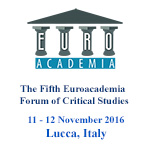Euroacademia Conferences
 Europe Inside-Out: Europe and Europeanness Exposed to Plural Observers (9th Edition) April 24 - 25, 2020
Europe Inside-Out: Europe and Europeanness Exposed to Plural Observers (9th Edition) April 24 - 25, 2020 Identities and Identifications: Politicized Uses of Collective Identities (9th Edition) June 12 - 13, 2020
Identities and Identifications: Politicized Uses of Collective Identities (9th Edition) June 12 - 13, 2020 8th Forum of Critical Studies: Asking Big Questions Again January 24 - 25, 2020
8th Forum of Critical Studies: Asking Big Questions Again January 24 - 25, 2020 Re-Inventing Eastern Europe (7th Edition) December 13 - 14, 2019
Re-Inventing Eastern Europe (7th Edition) December 13 - 14, 2019 The European Union and the Politicization of Europe (8th Edition) October 25 - 26, 2019
The European Union and the Politicization of Europe (8th Edition) October 25 - 26, 2019 Identities and Identifications: Politicized Uses of Collective Identities (8th Edition) June 28 - 29, 2019
Identities and Identifications: Politicized Uses of Collective Identities (8th Edition) June 28 - 29, 2019 The European Union and the Politicization of Europe (7th Edition) January 25 - 26, 2019
The European Union and the Politicization of Europe (7th Edition) January 25 - 26, 2019 7th Forum of Critical Studies: Asking Big Questions Again November 23 - 24, 2018
7th Forum of Critical Studies: Asking Big Questions Again November 23 - 24, 2018 Europe Inside-Out: Europe and Europeanness Exposed to Plural Observers (8th Edition) September 28 - 30, 2018
Europe Inside-Out: Europe and Europeanness Exposed to Plural Observers (8th Edition) September 28 - 30, 2018 Identities and Identifications: Politicized Uses of Collective Identities (7th Edition) June 14 - 15, 2018
Identities and Identifications: Politicized Uses of Collective Identities (7th Edition) June 14 - 15, 2018
‘Arte Argentino’ in Motion: Moving Through Aesthetic-Political Questions in the Artworks of Luís Felipe Noé and Marta Minujín
-
-

-
Presentation speakers
- Lena Geuer, Heinrich-Heine University Düsseldorf, Germany
Abstract:
Arte argentino is a term that was reinvented and popularized in the avant-garde art of the 1960ies in the 20th century in Argentina. During that period artists questioned their political, social and aesthetic conditions of life. The reactions to those conditions embodied by the art pieces and art movements were maybe the most radical ones in the history of art in Argentina. The main platform of the art scene was and still is the capital, Buenos Aires. The concept of “arte argentino” has been maintained until today and is still used as a category to represent pieces of art.(1) But why is it still necessary to talk about nation (argentino) when you want to talk about art (arte) in Argentina? That was a question I asked the art historian Rodrigo Alonso in an Interview in Buenos Aires in October 2014. His answer was that the issue of nationality remains relevant because contemporary art is always produced in an international context. Contemporary art, Alonso explains, can be seen as a category which encompasses different movements. Those movements or styles, for example concept art or oil paintings, were not invented in Argentina. Whenever I paint an oil painting, Alonso points out, I do incorporate the history of those materials and techniques I am using. In my paper, I want to verify that the “history of materials” in the context of art in Argentina has to be reconsidered. Alonso’s statement makes clear that not only materials and techniques have been transported from one place to another, but also historical contents and signification. These transported contents, however, will never appear isolated from already existing forms and materials in their ‘new’ places. Therefore material has to be considered as a dynamic, hybrid element which can-not be defined in a singular way. When I now ask: „What is art in Argentina?“, then I am referring to an isolated situation of form and material. But if I turn that question into: „How is art in Argentina and how did it became so?“, I can see mechanisms of transformation, conditions of production and different forms of identity processes. Based on the art works of Luís Felipe Noé and Marta Minujín which have been created with hybrid materials, forms and techniques from the sixties until now, I want to demonstrate that ‘arte argentino’ in its narrative and aesthetic appearance requires a thinking of materials and bodies in motion.
(1) Examples: Listen here now – Argentine art of the 60s, compilation of texts, published by Ines Katzenstein, 2004, MoMa, New York; IMÁN: Nueva York – Arte argentino de los ańos 60, exhibition curated by Rodrigo Alonso, PROA, Buenos Aires, 2010; Radical Shift – Transformaciones políticas y sociales en el arte argentino a partir de los ańos ´60, Museum Morsbroich, exhibition curated by Heike van den Valentyn, 2011. -
Related Presentations













